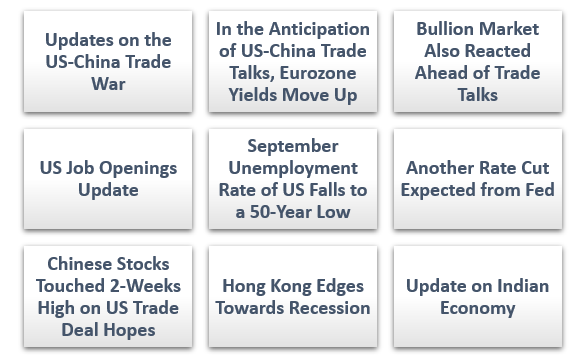Some experts believe that there is a considerable degree of interdependence between the equity markets of the US and other countries. It has been observed by analysts that there is some day-to-day linkage between the equity returns of the US and Asian equity markets. Whenever we think about the stock market, the first thing that comes in our mind is New York Stock Exchange or Nasdaq, because these two exchanges account for a major portion of equities in North America and worldwide. The United States is the leading economy in the world, having major stock exchanges like Nasdaq, New York Stock Exchange (NYSE) and Chicago Board Options Exchange.
The Asian market is majorly divided into two parts: The Developed Economies and the Developing Economies. The highly developed countries comprise Japan and Asian Tigers (Hong Kong, Singapore, South Korea and Taiwan). On the other hand, the developing economies include India, China, Bhutan, Cambodia, etc.
Let us take a look at the key events happening in the US and Asia Equity markets below:

Updates on the US-China Trade War:
The trade negotiators from the US and China have continued their trade talks in order to find out a middle ground of the 15 months trade war that is ongoing between the two players. U.S. trade representative Robert Lighthizer, Chinese Vice Premier Liu He and Treasury Secretary Steven Mnuchin are trying to reduce differences, which will be enough to avoid the tariff hike on $250 billion worth of Chinese goods, scheduled for Oct. 15.
The US government recently took a decision to blacklist twenty-eight Chinese public security bureaus, surveillance and technology firms, highlighting human rights breaches of Muslim minority groups in Chinaâs Xinjiang region. Next day, the U.S. State Department levied visa restrictions on Chinese officials regarding the Xinjiang issue, which affected the atmosphere surrounding the talks of US-China trade war negotiations.
In the Anticipation of US-China Trade Talks, Eurozone Yields Move Up:
Eurozone government bond yields increased slightly on 10th October as investors waited to learn on any development in trade talks between the US and China, and a crunch meeting between the Irish and British leaders over Brexit. Yields have gone up in recent days, but analysts stated that any gains are probably capped until any solution is reached over the prolonged trade conflict between the US and China, worldâs two largest economies.
Also, French industrial production has declined by 0.9 per cent in the month of August, against a projection of 0.3 per cent growth, but the production numbers were typically overlooked by the market as all people were eyeing the trade negotiations between China and the U.S.
Bullion Market Also Reacted Ahead of Trade Talks:
The Bullion market also reacted before the trade talks, with gold prices hitting $1,516.77/oz on 10th October 2019, the highest since 3rd October 2019.
The gold prices reached their one-week high level on Thursday as investors flocked to the safety of bullion following inconsistent reports about U.S.-China trade talks. Investors often use gold as a hedge against financial and political uncertainty.
US Job Openings Update:
U.S. job openings declined to a one and a half year low level to 7.05 million in the month of August and the hiring declined, demonstrating that employment growth has slowed down largely because of receding demand for labour as the economy loses impetus. The Labour Department reported the third straight monthly drop in vacancies, irrespective of that, job openings are still plenty enough to ease financial market fears of an impending recession. The job openings are being tightly scrutinized by the investors as they show signs of whether a loss in business confidence, which has hampered capital investment, is spilling over to employment.
September Unemployment Rate of US Falls to a 50-Year Low:
- The jobless rate in September fell 0.2 percentage points to 3.5 per cent, the gloomiest since December 1969;
- Past numbers were adjusted higher. August was amended up to 168k from an original estimate of 130k, while July was improved to 166k from 159k for a net gain of 45k;
- Nonfarm payrolls soared by 136k in September, under the 145k estimates by economists polled by Dow Jones;
- Wages soared by only 2.9 per cent for the year, the shortest rise since July 2018.
Another Rate Cut Expected from Fed:
U.S. producer prices unpredictably decreased in the month of September which led to the smallest annual increase in nearly three years which is expected to give the Federal Reserve further room to cut interest rates for the third time this year in October. The trade war which is been going from the past 15 months has pushed manufacturing into recession and eroded business investment.
Jerome Powell, the Chairman of Federal Reserve, has hinted that the Fed is likely to announce another rate cut later this month, because global growth has slowed and uncertainties around trade war, Brexit and other issues have made the outlook risky. The Fed has already reduced the range of federal funds rate to 1.75 to 2 per cent in mid-September, its second cut since July.
Chinese Stocks Touched 2-Weeks High on US Trade Deal Hopes:
Chinaâs stocks climbed to a two-week high level on 10th October as investors hoped for a fractional trade deal between US and China. However, a report stating that Chinese officials are likely to cut short their visit to the U.S. capped gains.
Hong Kong Edges Towards Recession:
Hong Kong is moving closer to the recession as a vital sign of the private sectorâs economic health plunged to a 10-year low, under the joint effect of the mounting US-China trade war and political instability in the city. It is been projected that Hong Kong will not be competent enough to prevent recession. Since early June, Hong Kong has been involved in its most terrible political crisis in last ten years.
Update on Indian Economy:
Indiaâs economic slowdown is one of the major drivers of slowdown in 2019 as India is the worldâs third largest economy on a PPP basis. The Reserve Bank of India (RBI) has aggressively reduced its policy rate, which is likely to help in an investment-led recovery, though downside risks to consumption remain.
So, these were the major things that have kept the investorsâ flocked to the US and the Asian equity markets. We will be back with further updates on these markets soon.
Disclaimer
This website is a service of Kalkine Media Pty. Ltd. A.C.N. 629 651 672. The website has been prepared for informational purposes only and is not intended to be used as a complete source of information on any particular company. Kalkine Media does not in any way endorse or recommend individuals, products or services that may be discussed on this site. Our publications are NOT a solicitation or recommendation to buy, sell or hold. We are neither licensed nor qualified to provide investment advice.




